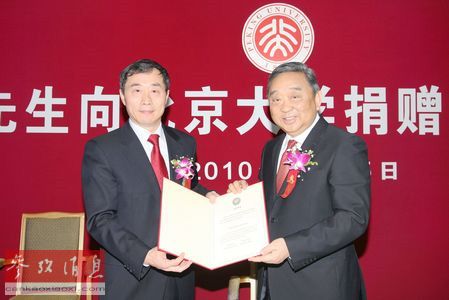Peking University, Oct. 29, 2013: It was reported by Japanese press that five Chinese universities, including Peking University (PKU), launched a new move that encouraged both Chinese and Japanese students to become roommates. The Japanese press complimented on this move, which was especially under the circumstances that China and Japan were having many controversial issues. This call was intended to develop interpersonal relations between young people from both countries, and Japan should also respond to it from a strategic perspective, commented by Japanese press.

Cao Qiyong (right) donated for the China-Japan Youth Exchange Center
According to a report of Yomiuri Shimbun on Oct. 24, Peking University China-Japan Youth Exchange Center was built on campus. One suite lived two students, one Chinese and the other one was Japanese. The exchange center was established last year with 60 students checking in this September.
Chinese universities used to offer local students and overseas students separate dorms, in order to avoid problems resulted from different living habits or culture shock. As a matter of fact, this led to overseas students’ lack of communication with Chinese students.
Yomiuri Shimbun did a survey on the students in the joint dorm. A junior Japanese student from Waseda University said, “I don’t feel any so-called anti-Japanese tendency on Chinese people around me. Everybody thinks we are all Asians.” A senior Chinese student said, “I don’t have any conflict living with Japanese.”
From next year on, Tsinghua University, Fudan University, Shanghai Jiao Tong University and Zhejiang University would also build this kind of joint dorms. Relevant conference was held this month to discuss the details, which was supported by Ministry of Education of China.
However, the joint-dorm plan was first proposed in 2010, when the incident of the collision of a Chinese fishing boat appeared near the Diaoyu Island waters and led to the deterioration of the relations between China and Japan. The program in Peking University was launched last year, no completion ceremony was held owing to the mass anti-Japanese protest all over the nation. But students still checked in as planned.
The initiator of the program was an industrialist named Cao Qiyong, who used to live in the Asian Cultural Hall for both Asian students and Japanese students, when he studied in Japan in the 1960s. He thought, “It is the time to do my duty.” He paid 100 million yuan for the program and persuaded people to pay attention.
The report announced that, to consider from a strategic point of view, it would be pretty essential for Japan to establish an interpersonal connection network with China’s next generation. If Chinese and Japanese students could live together, more and more Chinese young people would know about Japan, and wouldn’t be misled by unilateral propaganda of so-called “militarism”. This call met Japanese national interests.
According to the report, the joint dorms in the University of Tokyo, Kyoto University, Waseda University and Kyushu University were all under construction, while it might be slower than those of China. It was necessary for the Japanese government to offer more support.
Written by: Guo Caichen
Edited by: Qian Xin
Source: Xinhua Net